Effectiveness of Fiber Reinforcement on the Mechanical Properties and Shrinkage Cracking of Recycled Fine Aggregate Concrete
Abstract
:1. Introduction
2. Experimental Program
2.1. Materials
2.2. Specimens
2.3. Testing Methods
3. Results and Discussion
3.1. Properties of Fresh Concrete
3.2. Compressive Strength
3.3. Modulus of Elasticity
3.4. Splitting Tensile Strength and Flexural Strength
3.5. Shrinkage Cracking Behavior
4. Conclusions
- The compressive strength of all RFAC specimens was lower than that of N-0 regardless of fiber reinforcement. This behavior can be attributed to the influence of the weak mechanical bonding between recycled aggregate and cement paste [14,31,32]. The values of compressive strength of the fiber reinforced concretes were not found to be significantly different from the value of the compressive strength of non-reinforced RFAC.
- The splitting tensile strength and the flexural strength of R-0 were lower than those of N-0 specimens—26.1% and 18%, respectively. However, in cases of fiber-reinforced RFAC with a fiber volume fraction of 0.1%, the splitting tensile strength and flexural strength were similar to those of N-0. It can be inferred that fiber reinforcement of a small amount in RFAC contributed to an improvement in the interfacial bonding capacity between the cement matrix and aggregate.
- Regardless of the addition of fibers, the drying shrinkage of RFAC was higher than that of N-0. This result can be attributed to the influence of the higher porosity of the recycled fine aggregate [37,38]. This drawback of RFAC for drying shrinkage was improved by the addition of 0.1% PVA and nylon fibers, whose values were lower than the drying shrinkage of R-0 as 8.7% and 11.6% at the tested final ages, respectively. The reason for this behavior can be explained by the improvement in the bond between the cement matrix and coarse aggregate due to added fibers [41,42].
- The surface crack area of fiber-reinforced RFAC was significantly reduced according to increasing fiber volume fraction compared to that of N-0. These results were observed in both indoor accelerated plat-ring-type tests and long-term outdoor exposure slab-type tests. The results of R-0 in terms of cracking behavior were improved by effective reinforcement with PVA and nylon fibers. Fiber reinforcement with a small volume fraction in RFAC contributed to surface cracking resistance of concrete specimens.
- It was determined that the effectiveness of added fibers at a small volume fraction in RFAC with 100% fine aggregate replacement is significant for the reduction of surface cracks rather than for improvement of mechanical performance. However, to clarify the effect of fiber reinforcement with a small volume fraction for shrinkage cracking resistance, additional investigations of the influences of the variety of added fiber properties such as aspect ratio, organic or inorganic need to be addressed in future works.
Acknowledgments
Author Contributions
Conflicts of Interest
References
- Koo, B.M.; Kim, J.H.J.; Kim, S.B.; Mun, S.H. Material and structural performance evaluations of Hwangtoh admixtures and recycled PET fiber-added eco-friendly concrete for CO2 emission reduction. Materials 2014, 7, 5959–5981. [Google Scholar] [CrossRef]
- Fenollera, M.; Míguez, J.L.; Goicoechea, I.; Lorenzo, J. Experimental study on thermal conductivity of self-compacting concrete with recycled aggregate. Materials 2015, 8, 4457–4478. [Google Scholar] [CrossRef]
- Yoshitake, I.; Ishida, T.; Fukumoto, S. Recyclability of concrete pavement incorporating high volume of fly ash. Materials 2015, 8, 5479–5489. [Google Scholar] [CrossRef]
- Ann, K.Y.; Moon, H.Y.; Kim, Y.B.; Ryou, J. Durability of recycled aggregate concrete using pozzolanic materials. Waste Manag. 2008, 28, 993–999. [Google Scholar] [CrossRef] [PubMed]
- Ministry of Environment. Environmental Statistics Yearbook 2014. Available online: http://eng.me.go.kr/eng/web/index.do?menuId=29&findDepth=1 (accessed on 1 October 2015). (In Korean)
- Zaharieva, R.; Buyle-Bodin, F.; Wirquin, E. Frost resistance of recycled aggregate concrete. Cem. Concr. Res. 2004, 34, 1927–1932. [Google Scholar] [CrossRef]
- Pedro, D.; de Brito, J.; Evangelista, L. Influence of the use of recycled concrete aggregates from different sources on structural concrete. Constr. Build. Mater. 2014, 71, 141–151. [Google Scholar] [CrossRef]
- Pedro, D.; de Brito, J.; Evangelista, L. Performance of concrete made with aggregates recycled from precasting industry waste: Influence of the crushing process. Mater. Struct. 2015, 48, 3965–3978. [Google Scholar] [CrossRef]
- Manzi, S.; Mazzotti, C.; Bignozzi, M.C. Short and long-term behavior of structural concrete with recycled concrete aggregate. Cem. Concr. Compos. 2013, 37, 312–318. [Google Scholar] [CrossRef]
- Duan, Z.H.; Poon, C.S. Properties of recycled aggregate concrete made with recycled aggregates with different amounts of old adhered mortars. Mater. Des. 2014, 58, 19–29. [Google Scholar] [CrossRef]
- Evangelista, L.; de Brito, J. Criteria for the use of fine recycled concrete aggregate in concrete production. In Proceedings of the International RILEM Conference: The Use of Recycled Materials in Building and Structures, RILEM, Barcelona, Spain, 8–11 November 2004; pp. 503–510.
- Zega, C.J.; Di Maio, Á.A. Use of recycled fine aggregate in concretes with durable requirements. Waste Manag. 2011, 31, 2336–2340. [Google Scholar] [CrossRef] [PubMed]
- Yildirim, S.T.; Meyer, C.; Herfellner, S. Effects of internal curing on the strength, drying shrinkage and freeze-thaw resistance of concrete containing recycled concrete aggregates. Constr. Build. Mater. 2015, 91, 288–296. [Google Scholar] [CrossRef]
- Khatib, J.M. Properties of concrete incorporating fine recycled aggregate. Cem. Concr. Res. 2005, 35, 763–769. [Google Scholar] [CrossRef]
- Behnood, A.; Olek, J.; Glinicki, M.A. Predicting modulus elasticity of recycled aggregate concrete using M5′ model tree algorithm. Constr. Build. Mater. 2015, 94, 137–147. [Google Scholar] [CrossRef]
- Ho, N.Y.; Lee, Y.P.K.; Lim, W.F.; Zayed, T.; Chew, K.C.; Low, G.L.; Ting, S.K. Efficient utilization of recycled concrete aggregate in structural concrete. J. Mater. Civ. Eng. 2013, 25, 318–327. [Google Scholar] [CrossRef]
- Carneiro, J.A.; Lima, P.R.L.; Leite, M.B.; Filho, R.D.T. Compressive stress–strain behavior of steel fiber reinforced-recycled aggregate concrete. Cem. Concr. Compos. 2014, 46, 65–72. [Google Scholar] [CrossRef]
- Akça, K.R.; Çakır, Ö.; İpek, M. Properties of polypropylene fiber reinforced concrete using recycled aggregates. Constr. Build. Mater. 2015, 98, 620–630. [Google Scholar] [CrossRef]
- Mesbah, H.A.; Buyle-Bodin, F. Efficiency of polypropylene and metallic fibres on control of shrinkage and cracking of recycled aggregate mortars. Constr. Build. Mater. 1999, 13, 439–447. [Google Scholar] [CrossRef]
- Richardson, A.; Coventry, K.; Bacon, J. Freeze/thaw durability of concrete with recycled demolition aggregate compared to virgin aggregate concrete. J. Clean. Prod. 2011, 19, 272–277. [Google Scholar] [CrossRef]
- American Society for Testing Materials. Standard Specification for Concrete Aggregates; ASTM C33; ASTM International: West Conshohocken, PA, USA, 2013. [Google Scholar]
- Korean Standards Association. Recycled Aggregate for Concrete; KS F 2573; Korean Industrial Standards: Seoul, Korea, 2011. [Google Scholar]
- American Society for Testing Materials. Standard Test Method for Slump of Hydraulic-Cement Concrete; ASTM C143; ASTM International: West Conshohocken, PA, USA, 2015. [Google Scholar]
- American Society for Testing Materials. Standard Test Method for Air Content of Freshly Mixed Concrete by the Pressure Method; ASTM C231; ASTM International: West Conshohocken, PA, USA, 2014. [Google Scholar]
- American Society for Testing Materials. Standard Test Method for Compressive Strength of Cylindrical Concrete Specimens; ASTM C39; ASTM International: West Conshohocken, PA, USA, 2015. [Google Scholar]
- American Society for Testing Materials. Standard Test Method for Splitting Tensile Strength of Cylindrical Concrete Specimens; ASTM C496; ASTM International: West Conshohocken, PA, USA, 2004. [Google Scholar]
- American Society for Testing Materials. Standard Test Method for Flexural Strength of Concrete (Using Simple Beam with Third-Point Loading); ASTM C78; ASTM International: West Conshohocken, PA, USA, 2015. [Google Scholar]
- American Society for Testing Materials. Standard Test Method for Determining Age at Cracking and Induced Tensile Stress Characteristics of Mortar and Concrete under Restrained Shrinkage; ASTM C1581; ASTM International: West Conshohocken, PA, USA, 2009. [Google Scholar]
- Kim, G.Y.; Nam, J.S.; Choi, H.G.; Kim, Y.S.; Lee, E.B.; Lee, D.H. Reasonable properties evaluation of plat-ring type test method for restrained shrinkage cracking properties of concrete. J. Arch. Inst. Korea 2009, 25, 89–96. (In Korean) [Google Scholar]
- American Society for Testing Materials. Standard Test Method for Evaluating Plastic Shrinkage Cracking of Restrained Fiber Reinforced Concrete (Using a Steel Form Insert); ASTM C1579; ASTM International: West Conshohocken, PA, USA, 2013. [Google Scholar]
- Evangelista, L.; de Brito, J. Mechanical behaviour of concrete made with fine recycled concrete aggregates. Cem. Concr. Compos. 2007, 29, 397–401. [Google Scholar] [CrossRef]
- Katz, A. Properties of concrete made with recycled aggregate from partially hydrated old concrete. Cem. Concr. Res. 2003, 33, 703–711. [Google Scholar] [CrossRef]
- Jiang, C.; Fan, K.; Wu, F.; Chen, D. Experimental study on the mechanical properties and microstructure of chopped basalt fibre reinforced concrete. Mater. Des. 2014, 58, 187–193. [Google Scholar] [CrossRef]
- Borg, R.P.; Baldacchino, O.; Ferrara, L. Early age performance and mechanical characteristics of recycled PET fibre reinforced concrete. Constr. Build. Mater. 2016, 108, 29–47. [Google Scholar] [CrossRef]
- Jang, S.J.; Rokugo, K.; Park, W.S.; Yun, H.D. Influence of rapid freeze-thaw cycling on the mechanical properties of sustainable strain-hardening cement composite (2SHCC). Materials 2014, 7, 1422–1440. [Google Scholar] [CrossRef]
- Silva, R.V.; de Brito, J.; Dhir, R.K. Tensile strength behavior of recycled aggregate concrete. Constr. Build. Mater. 2015, 83, 108–118. [Google Scholar] [CrossRef]
- Fan, C.C.; Huang, R.; Hwang, H.; Chao, S.J. The effects of different fine recycled concrete aggregates on the properties of mortar. Materials 2015, 8, 2658–2672. [Google Scholar] [CrossRef]
- Gómez-Soberón, J.M.V. Porosity of recycled concrete with substitution of recycled concrete aggregate: An experimental study. Cem. Concr. Res. 2002, 32, 1301–1311. [Google Scholar] [CrossRef]
- Passuello, A.; Moriconi, G.; Shah, S.P. Cracking behavior of concrete with shrinkage reducing admixtures and PVA fibers. Cem. Concr. Compos. 2009, 31, 699–704. [Google Scholar] [CrossRef]
- Choi, H.; Lim, M.; Kitagaki, R.; Noguchi, T.; Kim, G. Restrained shrinkage behavior of expansive mortar at early ages. Constr. Build. Mater. 2015, 84, 468–476. [Google Scholar] [CrossRef]
- Banthia, N.; Gupta, R. Influence of polypropylene fiber geometry on plastic shrinkage cracking in concrete. Cem. Concr. Res. 2006, 36, 1263–1267. [Google Scholar] [CrossRef]
- Qi, C.; Weiss, J.; Olek, J. Characterization of plastic shrinkage cracking in fiber reinforced concrete using image analysis and a modified Weibull function. Mater. Struct. 2003, 36, 386–395. [Google Scholar] [CrossRef]
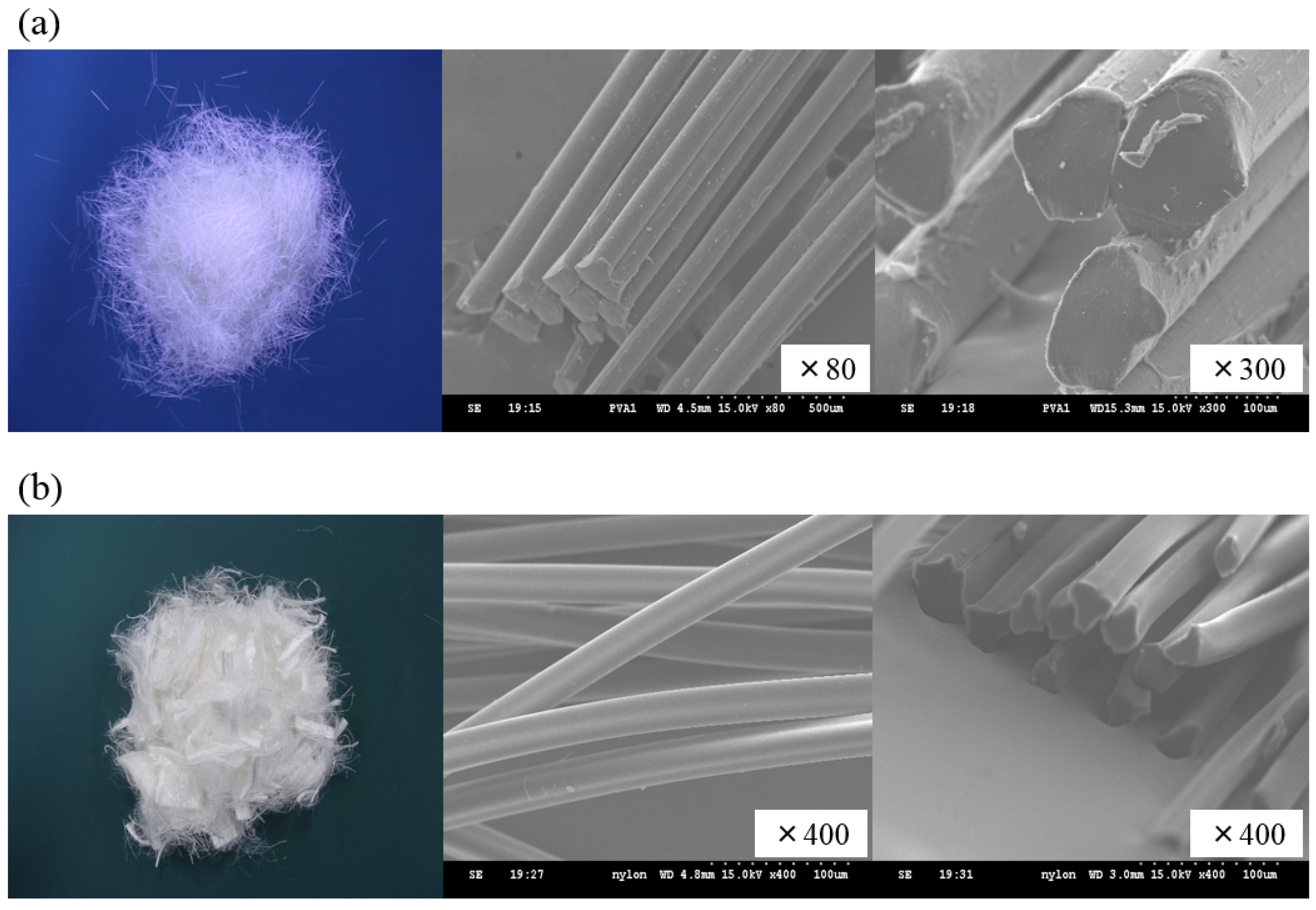
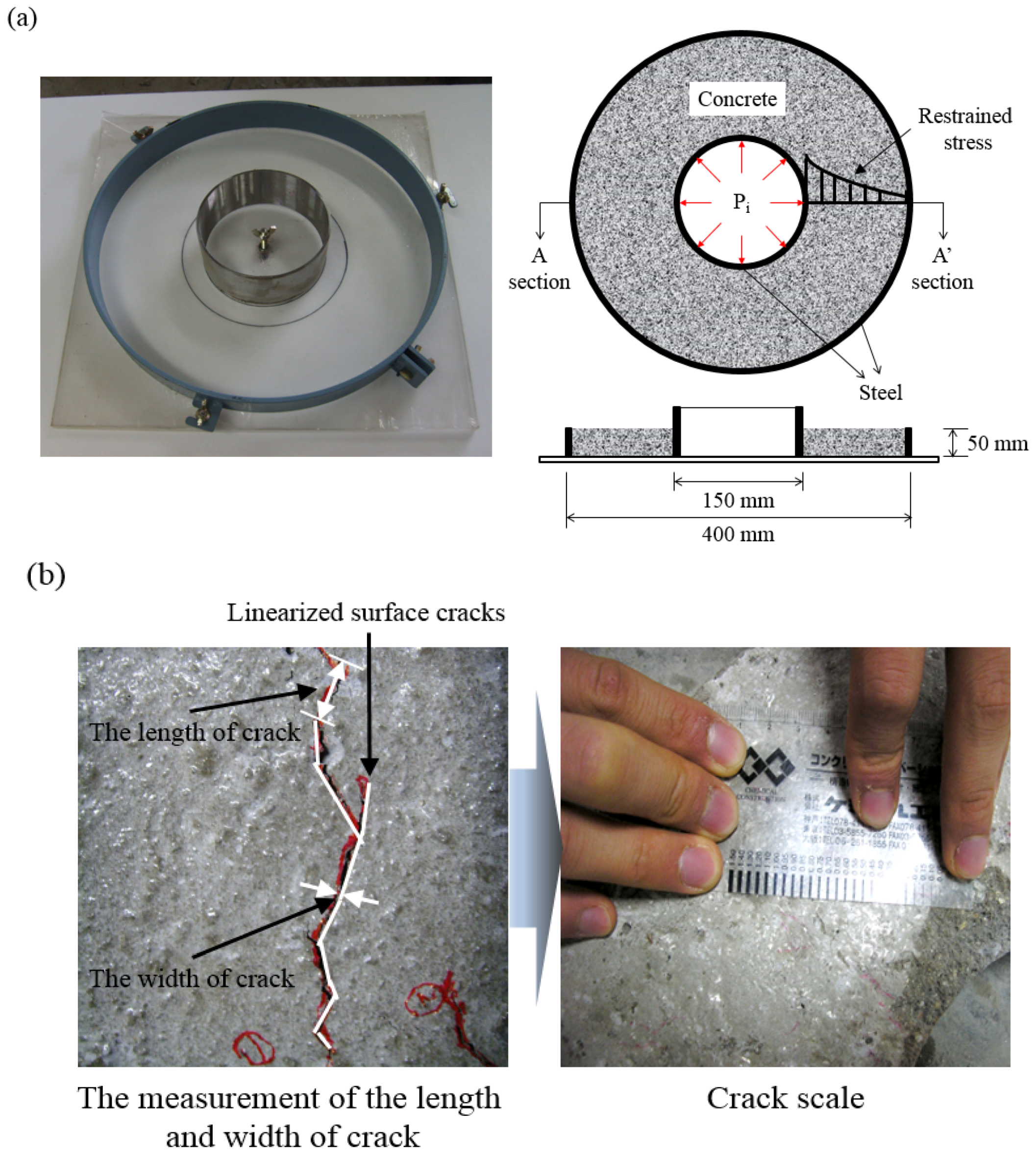
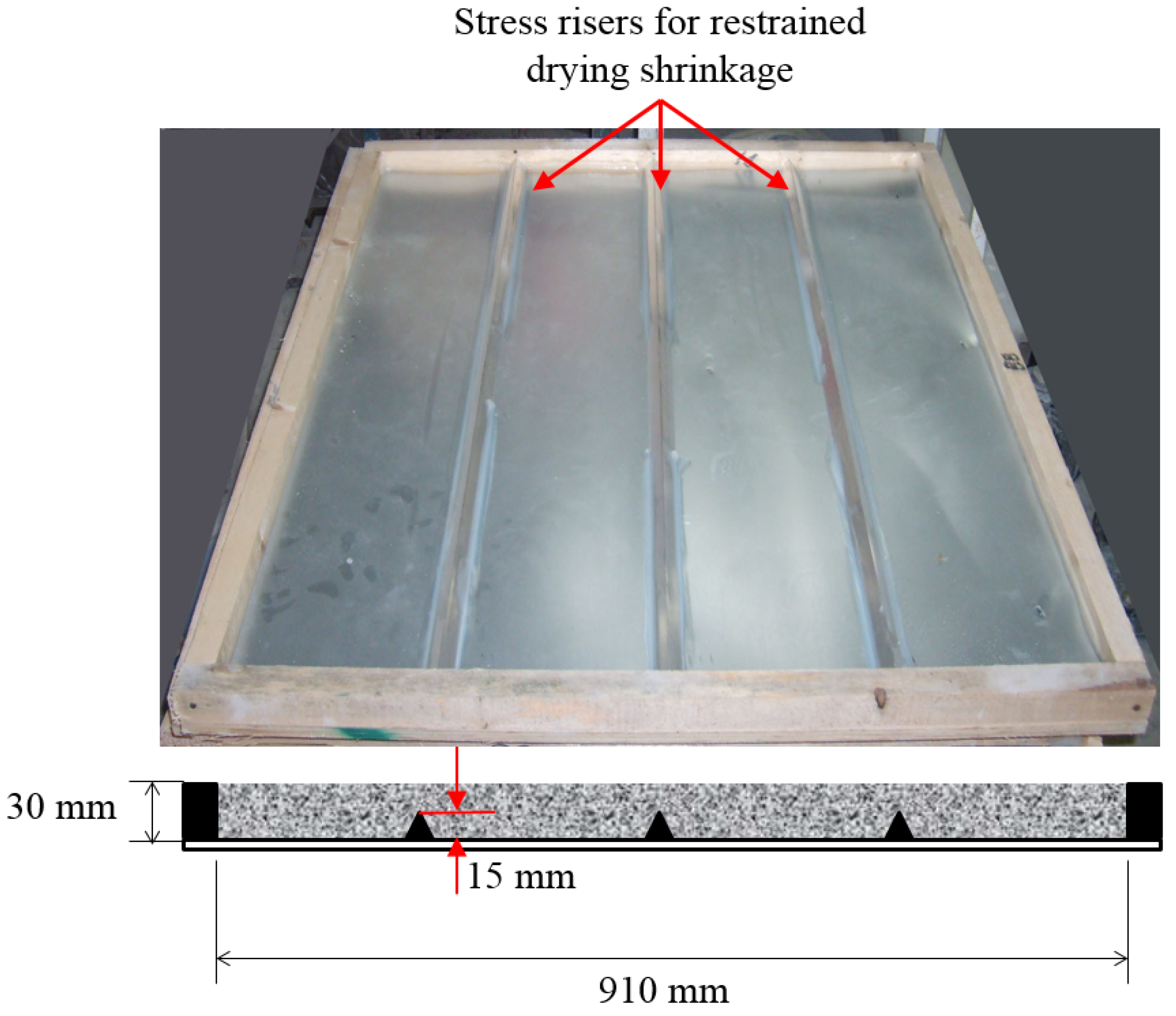
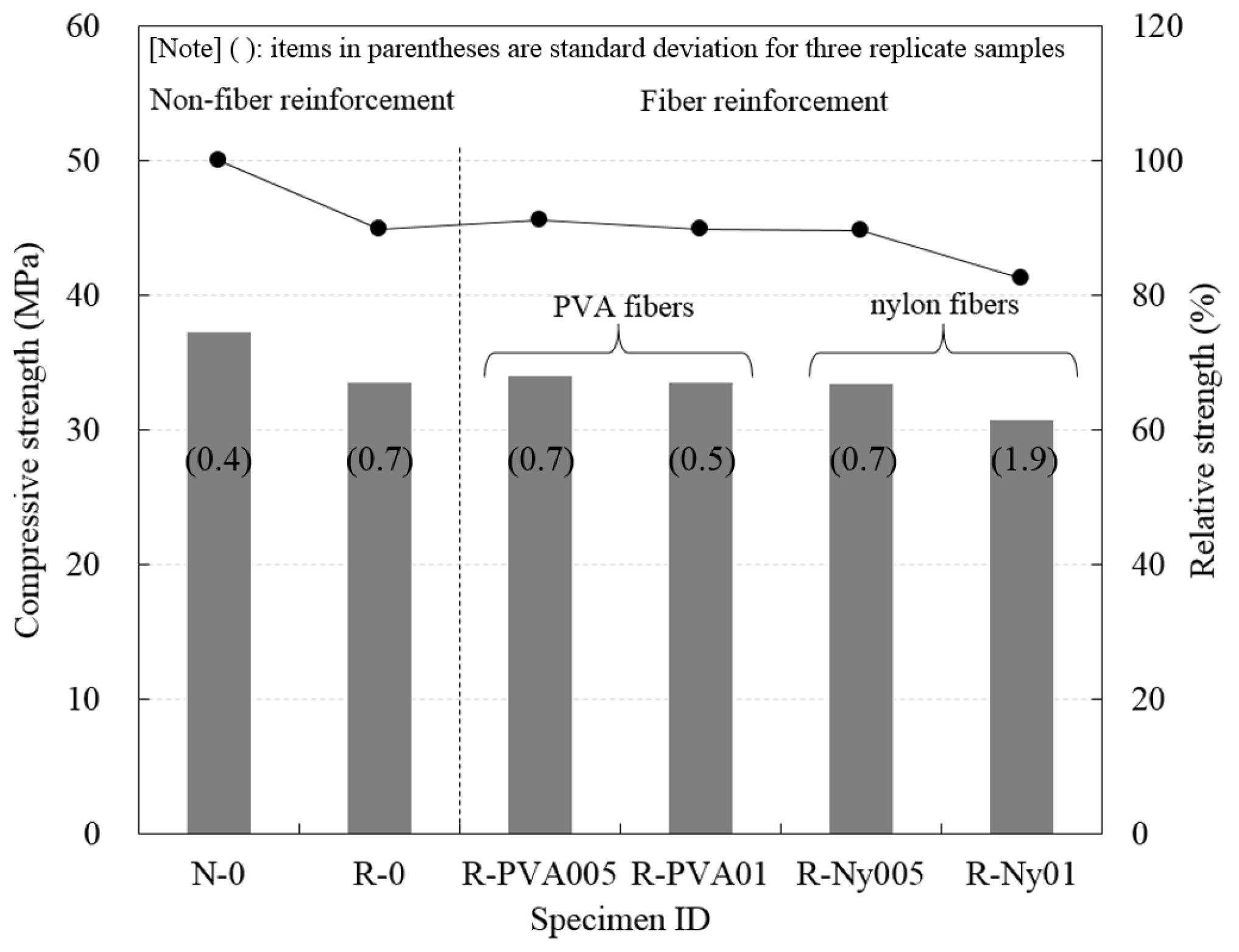
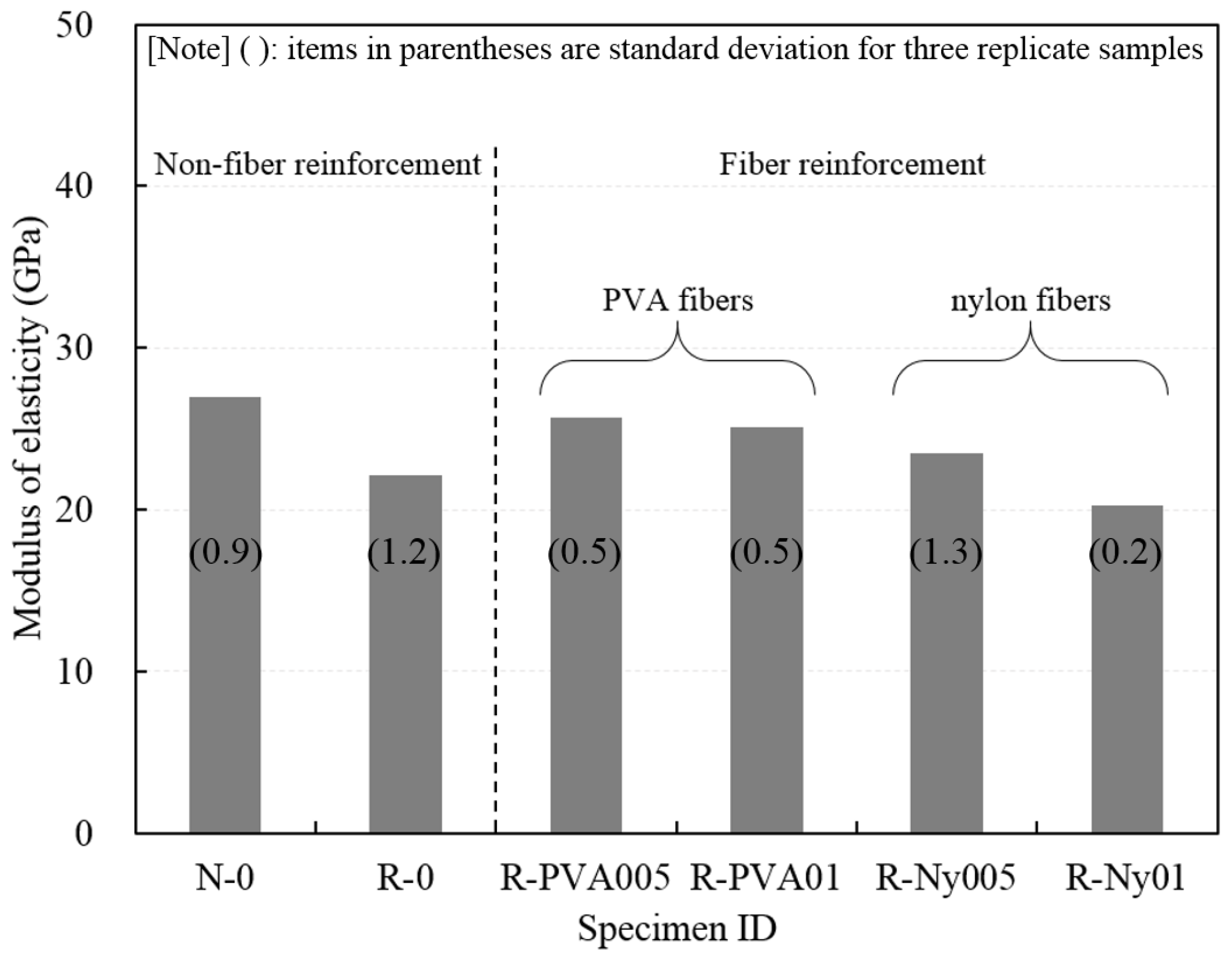
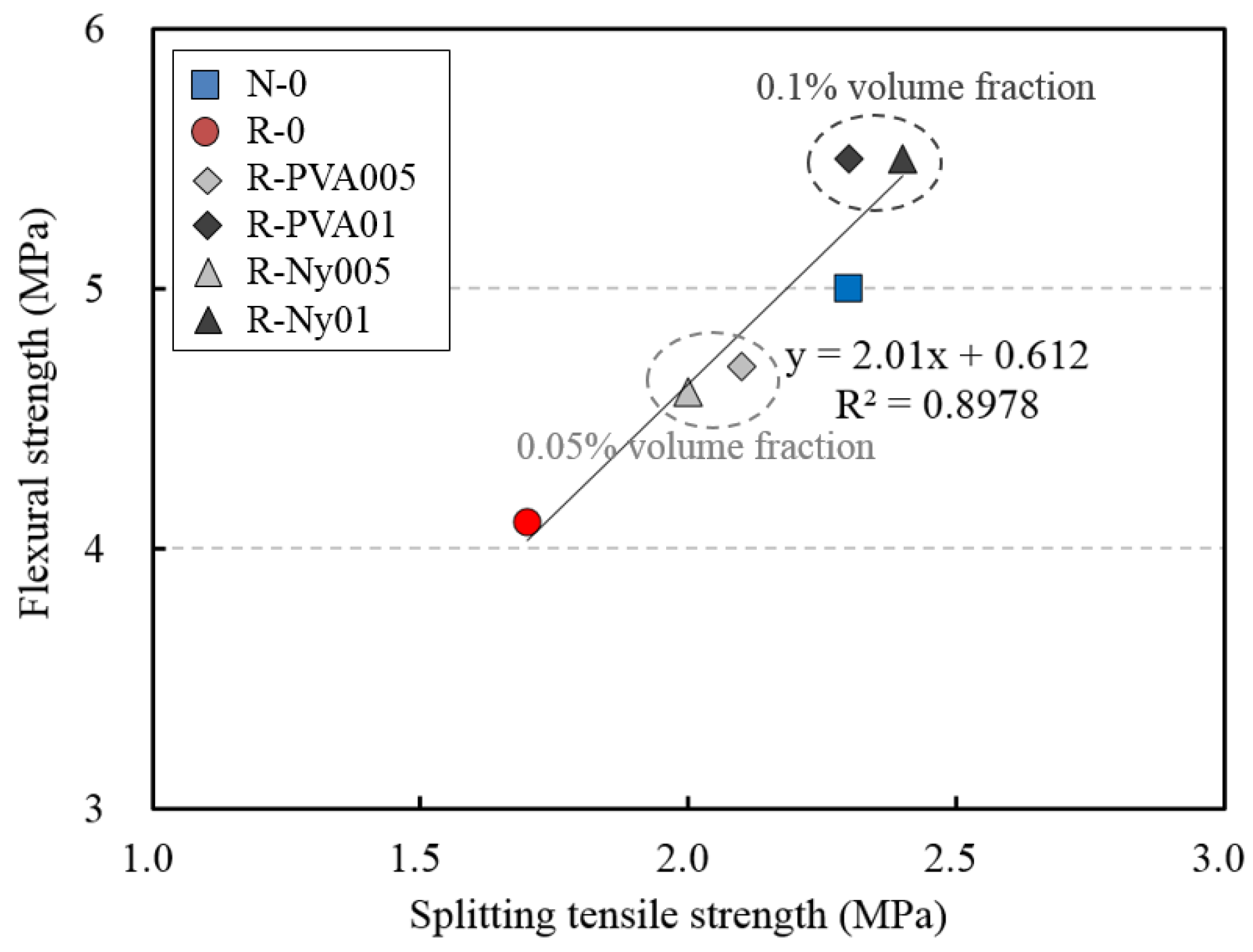
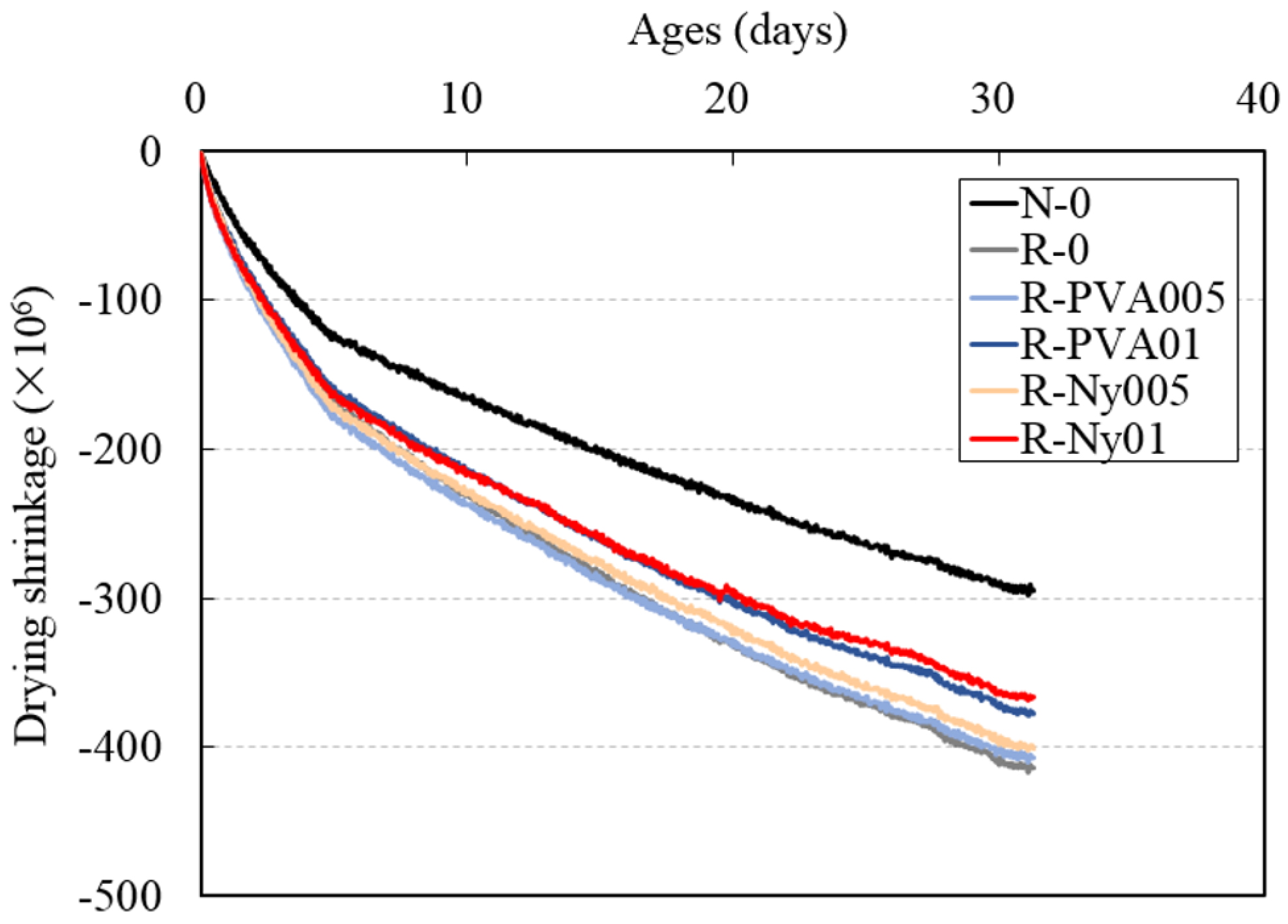
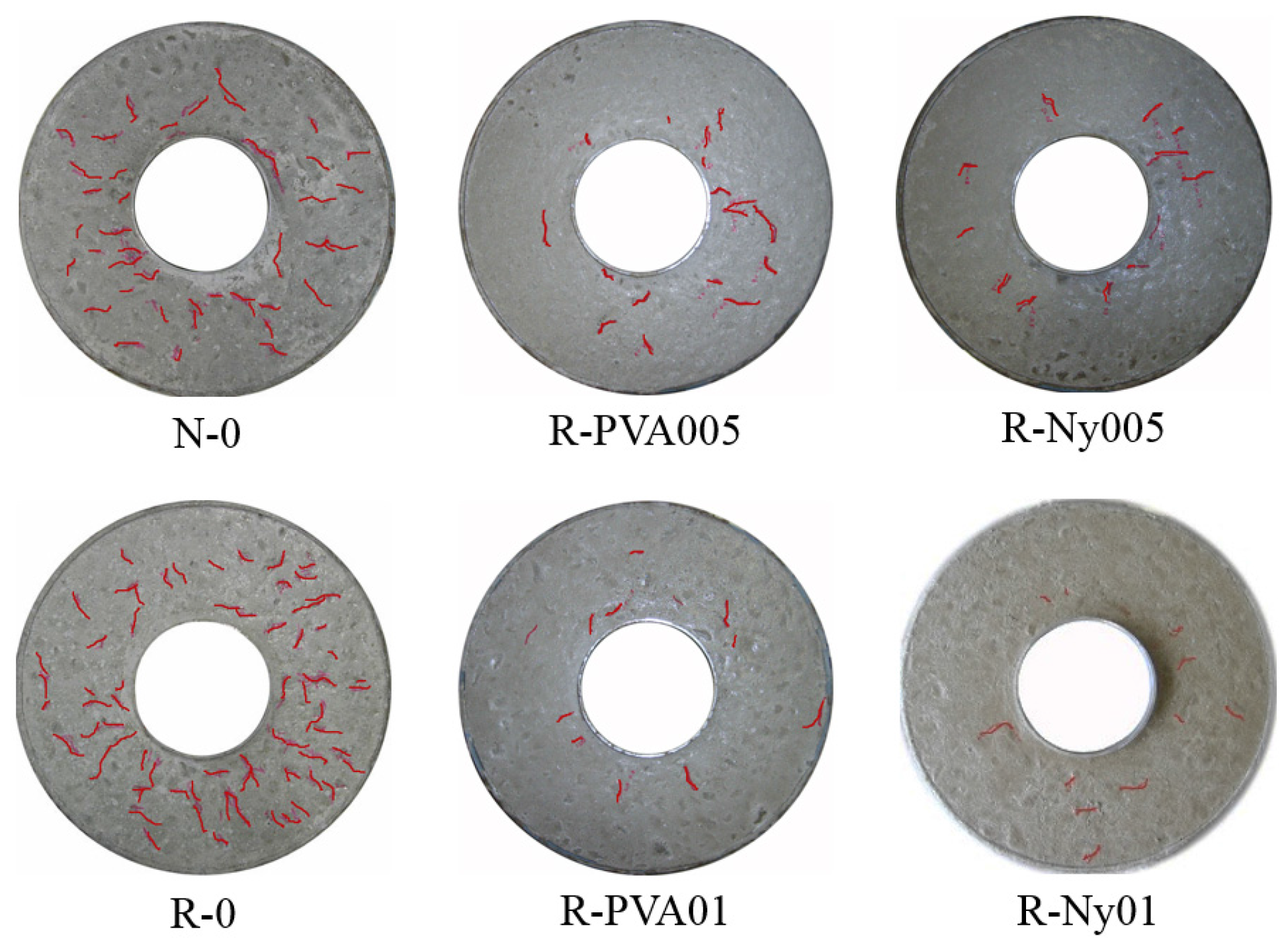
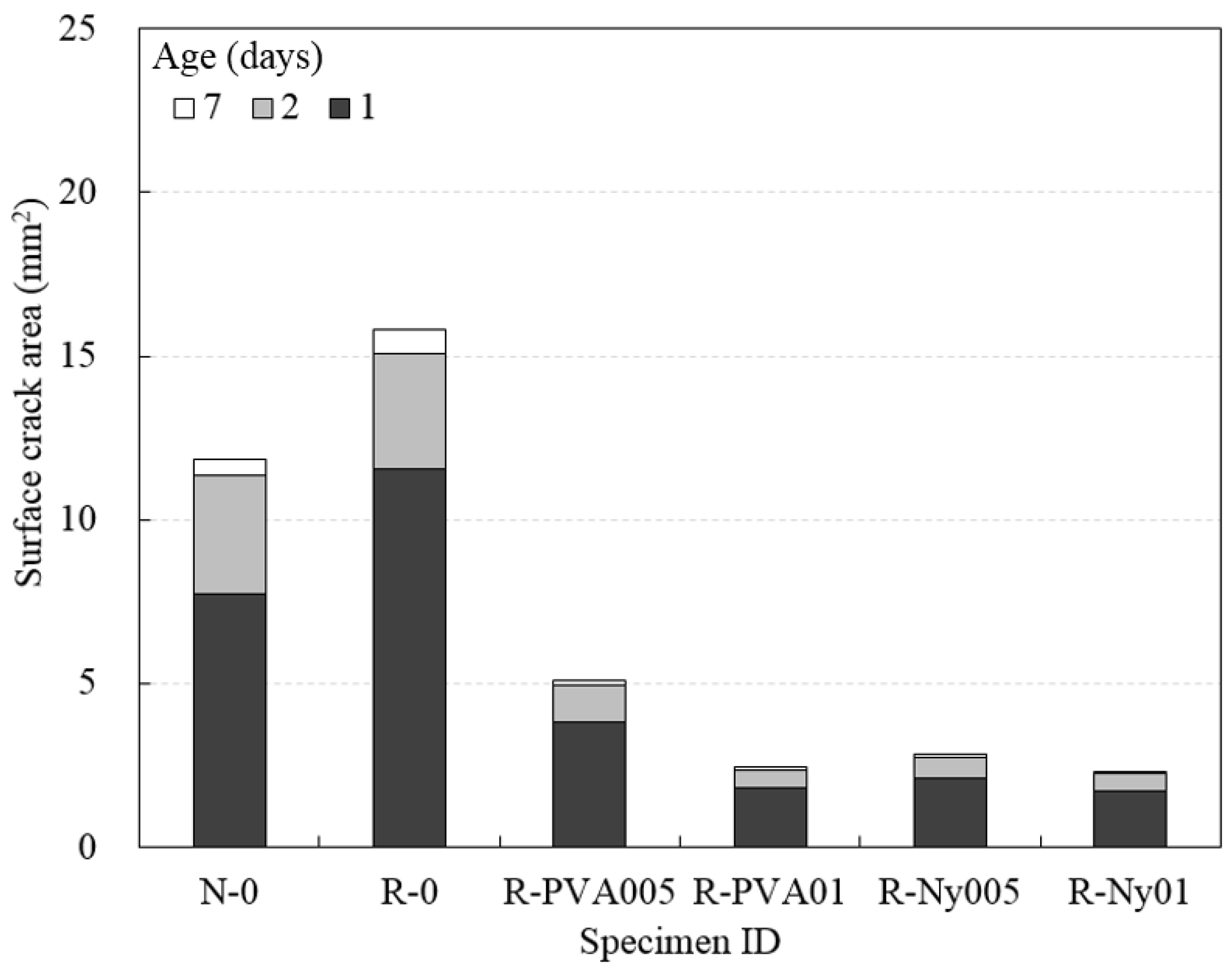
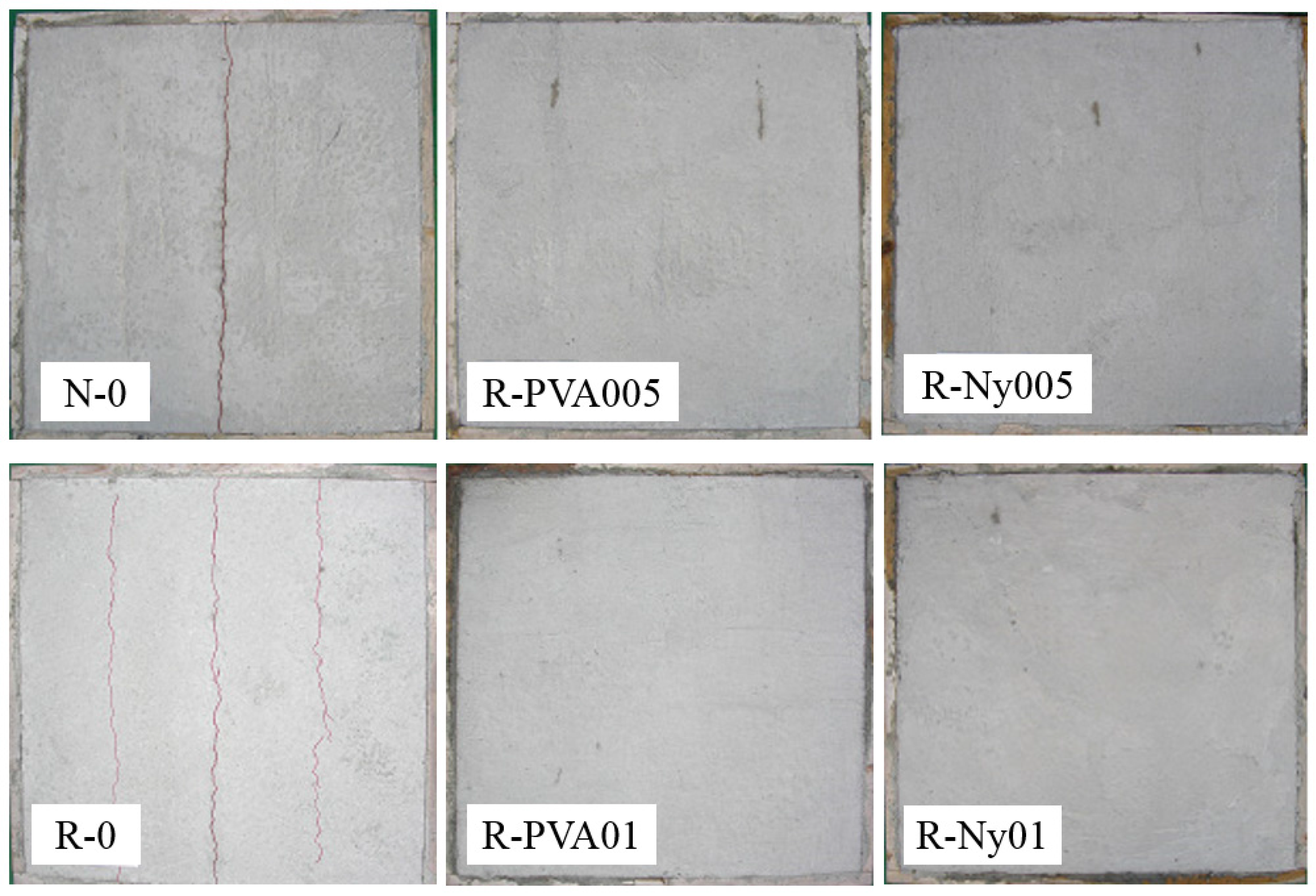
| Materials | Properties |
|---|---|
| Cement | Ordinary Portland cement |
| Density: 3.15 (g/cm3) | |
| Blaine fineness: 3770 (cm2/g) | |
| Natural fine aggregate (river sand) | Density: 2.61 (g/cm3) |
| Water absorption: 1.42 (%) | |
| Fineness modulus: 2.84 | |
| Coarse aggregate | Maximum size: 25 (mm) |
| Density: 2.65 (g/cm3) | |
| Water absorption: 1.39 (%) |
| Property | Required by KS F 2573 | Used |
| Density (g/cm3) | ≥2.2 | 2.52 |
| Water absorption (%) | ≤5.0 | 4.90 |
| Loss on 0.08 mm sieve passing (%) | ≤7.0 | 3.75 |
| Impurity (%) | ≤1.0 | 0.07 |
| Sieve Analysis (Passing, %) | Standard Range | Measured Value |
| 5 mm | 90–100 | 100 |
| 2.5 mm | 80–100 | 99 |
| 1.2 mm | 50–90 | 86 |
| 0.6 mm | 25–65 | 65 |
| 0.3 mm | 10–35 | 33 |
| 0.15 mm | 2–15 | 12 |
| Fiber Type | Specific Density (g/cm3) | Length (mm) | Diameter (μm) | Tensile Strength (MPa) | Elastic Modulus (GPa) |
|---|---|---|---|---|---|
| PVA | 1.30 | 12 | 200 | 910 | 29 |
| Nylon | 1.16 | 19 | 23 | 896 | 5.17 |
| ID a | W/C b (%) | Cement (kg/m3) | S/A c (%) | Water (kg/m3) | Coarse Aggregate (kg/m3) | NFA d (kg/m3) | RFA (kg/m3) | Fiber (Vf %) e | SP f (kg/m3) |
|---|---|---|---|---|---|---|---|---|---|
| N-0 | 50 | 352 | 47 | 176 | 944 | 809 | - | - | 0.7 |
| R-0 | 50 | 352 | 47 | 176 | 944 | - | 727 | - | 0.7 |
| R-PVA005 | 50 | 352 | 47 | 176 | 944 | - | 727 | 0.05 | 0.7 |
| R-PVA01 | 50 | 352 | 47 | 176 | 944 | - | 727 | 0.1 | 1.4 |
| R-Ny005 | 50 | 352 | 47 | 176 | 944 | - | 727 | 0.05 | 1.4 |
| R-Ny01 | 50 | 352 | 47 | 176 | 944 | - | 727 | 0.1 | 1.8 |
| ID | Slump (mm) a | Air Content (%) | SP (kg/m3) |
|---|---|---|---|
| N-0 | 200 | 3.2 | 0.7 |
| R-0 | 184 | 3.5 | 0.7 |
| R-PVA005 | 175 | 5.6 | 0.7 |
| R-PVA01 | 165 | 5.5 | 1.4 |
| R-Ny005 | 165 | 6.0 | 1.4 |
| R-Ny01 | 185 | 7.5 | 1.8 |
| Specimen ID | Density (kg/m3) |
|---|---|
| N-0 | 2709 |
| R-0 | 2591 |
| R-PVA005 | 2606 |
| R-PVA01 | 2556 |
| R-Ny005 | 2560 |
| R-Ny01 | 2486 |
| ID | Splitting Tensile Strength (MPa) a | Flexural Strength (MPa) a |
|---|---|---|
| N-0 | 2.3 | 5.0 |
| R-0 | 1.7 | 4.1 |
| R-PVA005 | 2.1 | 4.7 |
| R-PVA01 | 2.3 | 5.5 |
| R-Ny005 | 2.0 | 4.6 |
| R-Ny01 | 2.4 | 5.5 |
| Specimen ID | Surface Crack Area (mm2) |
|---|---|
| N-0 | 35.86 |
| R-0 | 42.64 |
| R-PVA005 | 1.24 |
| R-PVA01 | 0.70 |
| R-Ny005 | 1.17 |
| R-Ny01 | 0.68 |
© 2016 by the authors; licensee MDPI, Basel, Switzerland. This article is an open access article distributed under the terms and conditions of the Creative Commons by Attribution (CC-BY) license (http://creativecommons.org/licenses/by/4.0/).
Share and Cite
Nam, J.; Kim, G.; Yoo, J.; Choe, G.; Kim, H.; Choi, H.; Kim, Y. Effectiveness of Fiber Reinforcement on the Mechanical Properties and Shrinkage Cracking of Recycled Fine Aggregate Concrete. Materials 2016, 9, 131. https://doi.org/10.3390/ma9030131
Nam J, Kim G, Yoo J, Choe G, Kim H, Choi H, Kim Y. Effectiveness of Fiber Reinforcement on the Mechanical Properties and Shrinkage Cracking of Recycled Fine Aggregate Concrete. Materials. 2016; 9(3):131. https://doi.org/10.3390/ma9030131
Chicago/Turabian StyleNam, Jeongsoo, Gyuyong Kim, Jaechul Yoo, Gyeongcheol Choe, Hongseop Kim, Hyeonggil Choi, and Youngduck Kim. 2016. "Effectiveness of Fiber Reinforcement on the Mechanical Properties and Shrinkage Cracking of Recycled Fine Aggregate Concrete" Materials 9, no. 3: 131. https://doi.org/10.3390/ma9030131
APA StyleNam, J., Kim, G., Yoo, J., Choe, G., Kim, H., Choi, H., & Kim, Y. (2016). Effectiveness of Fiber Reinforcement on the Mechanical Properties and Shrinkage Cracking of Recycled Fine Aggregate Concrete. Materials, 9(3), 131. https://doi.org/10.3390/ma9030131






